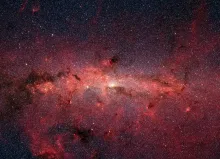
Credit: NASA/JPL-Caltech/S. Stolovy (Spitzer Science Center/Caltech), Public domain, via Wikimedia Commons
Welcome to Astro-Observer.com!
This is our ultimate resource for the captivating hobby of amateur astronomy. Whether you are a seasoned stargazer or just beginning your journey into the cosmos, our website offers a wealth of information and community support to enhance your experience under the night sky.
Explore the Night Sky
At Astro-Observer, we are passionate about the wonders of the universe and the joy of observing celestial objects. Our site provides detailed guides and tips for observing:
- Planets: Discover the secrets of our solar system's planets, from the shimmering beauty of Venus to the distant, icy realms of Neptune.
- Star Clusters: Learn about the various star clusters, both open and globular, and how to spot these stellar groupings with your telescope.
- Galaxies: Venture beyond our Milky Way and explore the majestic spiral and elliptical galaxies scattered across the universe.
- Messier Objects: Dive into the catalog of Messier objects, including nebulae, star clusters, and galaxies, all waiting to be observed.
Astronomy Equipment
Choosing the right equipment is crucial for a rewarding stargazing experience. At Astro-Observer, we provide comprehensive reviews and guides on:
- Telescopes: From beginner scopes to advanced setups, find the perfect telescope to suit your needs and budget.
- Binoculars: Learn how a good pair of binoculars can enhance your skywatching experience, especially for wide-field observations.
- Accessories: Explore essential accessories like star charts, filters, and eyepieces that can make your stargazing sessions more enjoyable and productive.
Events and Community
Engaging with fellow astronomy enthusiasts can greatly enrich your hobby. We keep you informed about:
- Star Parties: Join organized gatherings where you can share your passion with others, observe through various telescopes, and learn from experienced astronomers.
- Conventions: Attend conventions to stay updated on the latest in astronomy equipment, meet industry experts, and participate in workshops and lectures.
Light Pollution and Dark Sky Locations
One of the biggest challenges for astronomers is light pollution, which obscures the beauty of the night sky. At Astro-Observer, we discuss:
- Light Pollution: Understand the causes and effects of light pollution, and learn how you can contribute to reducing it in your area.
- Dark Sky Locations: Find the best dark sky sites near you where you can experience the night sky in all its glory, away from the intrusive glow of city lights.
We invite you to explore Astro-Observer and become part of our vibrant community. Whether you're here to learn, share, or simply marvel at the wonders above, we are delighted to have you with us. Happy stargazing!
